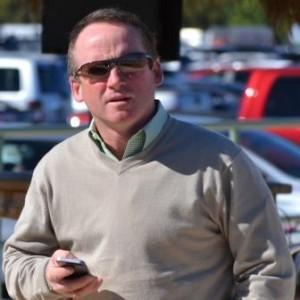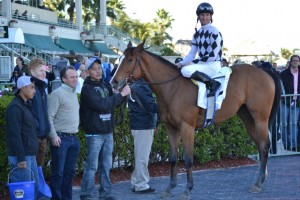Meet Brendan Walsh – The Ups and Downs of a Horse Trainer
When he started training three years ago, Brendan Walsh bought enough equipment for a dozen horses. That wasn’t enough. It went to twenty and now it’s 32 horses in his stable. He expects to have between 40 and 45 horses over the summer. The day after we interviewed Brendan, he won his 3rd consecutive start at Gulfstream Park. In 2014, he cracked the $1 million mark for purses earned. So, the life of a horse trainer is a bed of roses, huh. Well, listen to Brendan’s story before you give up your day job to try it out.
Brendan Walsh grew up on a farm in County Cork, Ireland. That gave him plenty of exposure to animals, but not horses … until he got a pony. He had to teach himself how to ride, since no one in his family “had a clue.” Brendan described his relationship with the pony, “For about two years that pony would buck and kick and run off on me. My dad said anyone else would have just quit. But, I’d keep getting back on him, and eventually I got him going pretty good.”
Brendan was obsessed with horses from the get-go and decided he wanted to be a jockey. He said, “On Saturday afternoons, they couldn’t get me off the arm of the chair. I’d be watching racing on TV and riding races on the arm of the chair.” At 15 years old, he briefly attended an apprentice school for jockeys, but came back home. He explained, “Maybe I was homesick. I might have been a bit soft at that time, but fifteen is a bit young for a kid to leave home.”
Brendan went back to school, but never lost his love for horses. After school, he worked for an equine veterinarian, who later helped him get into the Irish Stud Management course. He worked at stud farms, but couldn’t get the thrill of racing out of his system, so he went to work for Sheik Mohammed at Kildare, where they broke yearlings. Brendan explained his role, “They’d keep horses over the summer and kind of pre-train them, so I used to ride them.” Later he went to work for John Hammond in France and eventually went to Dubai with yearlings broken for Godolphin that he was galloping. Following that he went to work for Godolphin full-time.
By this time, Brendan had decided he wanted to train horses and eventually he decided to leave Godolphin because “I wanted to learn what it was going to be like training on my own. When you’re training for the Maktuoms, you’ve got tons of well-bred horses and you don’t get into the nitty gritty of what you have to learn to train on your own.”
In his quest to learn more, Brendan went to work for Mark Wallace in Newmarket as an assistant trainer. He spent three years in Newmarket. He said, “It was a great experience, but I was always interested in American racing.” So Brendan headed for America, where he met the trainer Eddie Kenneally and began working for him in October of 2007. Eddie instilled in Brendan the importance of being organized. He describes it, “You set things up right … before the morning starts. Everybody knows their job and that translates to the horses as well. That was a great thing about Eddie. And if you ask Tom, he’ll tell you the same thing.”
Brendan is referring to Tom Morley, who came to work for Eddie later. They worked together for a period of six months. He said, “When I was there with Tom, we’d go through in the morning, me on one side, Tom on the other, and we’d meet halfway. And I’d say is there anything we need to look at on your side? And, then Eddie would come and we’d tell him, so he knew what was going on. And then the training started. It’s attention to detail, because small things get out of hand and then they spiral. I think that’s what the great trainers do … they see it before it happens.”
After working with Eddie for about three years, Brendan decided it was time to start training on his own. He knew, as an assistant trainer, ultimately the problems are not your own, and to complete his learning experience he had to go there next. It was a rough start for Brendan as a head trainer. He explained, “I had a tough first year. I look back at it now and … I don’t know if I realized it or not. How did I survive? It tests your character, that’s for sure. But I learned a lot of valuable lessons that will help me out later.”
For Brendan, the financial worries were the toughest part. In his 2nd year there was an owner that owed him a lot of money and he almost went under waiting to be paid. Fortunately, he received help in collecting the debt and eventually did get paid. In describing his situation, he said “There’s no point in having a horse, no matter how good he is, if you’re not getting paid. It’s a major hazard for young trainers. It affects you mentally, because you worry about it, and you can’t concentrate on the thousand other things you should be worrying about.”
Thanks to a very astute claim, his financial situation eventually improved. With his own money, he claimed a horse named Cary Street for $10,000. He went on to win a Grade-3 and Grade-2 Stakes race, with the latter coming on Breeders’ Cup day in a 1 ¾ mile marathon race. Brendan talked about his Big Horse, “He was a shell of a horse when I claimed him. He had talent, but physically he needed time. I always thought he could run all day, but I needed to get another year under his belt and get him strong.
So Cary Street needed time to mature, and in the end he rewarded Brendan nicely for his patience. Brendan explains his approach, “I try to get the best out of every horse, whether they’re good or bad. Some horses just need time and a chance to mature. When people are worried about stats, it turns into a numbers game, and I think a lot of nice horses slip under the radar. And everybody is guilty of making that mistake.”
As a further example, Brendan tells about another horse in his barn, “I have a 3-year old horse that’s going to be a real nice horse this year, and last year he was a big baby. He just needed to run, or he wasn’t going to mature, so I had to run him those times even though I knew he wasn’t going to win. But, once I get him going this year he’ll pay me back.”
So, there are some of the highs, but as every trainer learns quickly, there are just as many (if not more) lows in this business. Once again, Brendan schooled from Eddie Kenneally on how to deal with this aspect of the sport. He said, “Eddie was a stickler for small things, but if something big happened … like a horse getting injured, he was a great man to take bad news. You try to prevent it as best you can, and you work hard, and if it works … it works. And if it doesn’t, you can’t beat yourself up too much. I learned that from Eddie.”
Coping with the ups and downs that occur every day in this business will cause most trainers to become quite humble. Brendan is no exception. On the subject of humility, he said, “The second you start thinking you’ve got it figured out, it will bring you right back down. After we won the Stakes race on Breeders’ Cup Day this year … about a week later, I was working a filly up in Louisville. She broke down and I had to put her down. You go home and … you’ve got this picture of the horse in your mind. That really breaks your heart. Because I love horses. Some people treat it as just a business and the horses are instruments. But for me, they’re like pets, a part of the family.”
Brendan continues, “That goes to show the two extremes. I had to call that filly’s owner and tell him the bad news, and that’s the ultimate bad news right there. You’re humbled … because that can happen, and it was nobody’s fault … she just took a bad step. It can happen to the soundest horse in the world. You actually hate yourself for awhile, and you’re thinking why I am I even doing this? But, that’s because you love the horses so much. So, you try and put a brave face on, and get on with it the next day. You’ve got people depending on you.”
So you press on – as any professional will do, in any walk of life, after having a bad day. Brendan summed up the roller coaster ride of training this way, “You’ll be having a good run with horses, and then you hit phases where nothing goes right. You get a horse fit, ready for a race, and then five days before the race he starts coughing. But then it starts to go right. You run a horse that’s 10-1 and you don’t really expect him to win, and he goes out and wins. Or a couple of horses start working good. It can change in just one morning, when you come in and you see something bad, like an ankle … and you’re like, Ohhh No, it’s gonna be a bad day! But then, two hours later you go out and some horse works off the charts, you’re like wow, this horse is flying. It’s such a range of emotions you go through. So many ups and downs.”
Brendan, thank you for providing me the opportunity to visit with you and for sharing your experiences with our readers. It’s always eye opening to hear about the “ups and downs” in the life of a horse trainer.





8 comments on “Meet Brendan Walsh – The Ups and Downs of a Horse Trainer”